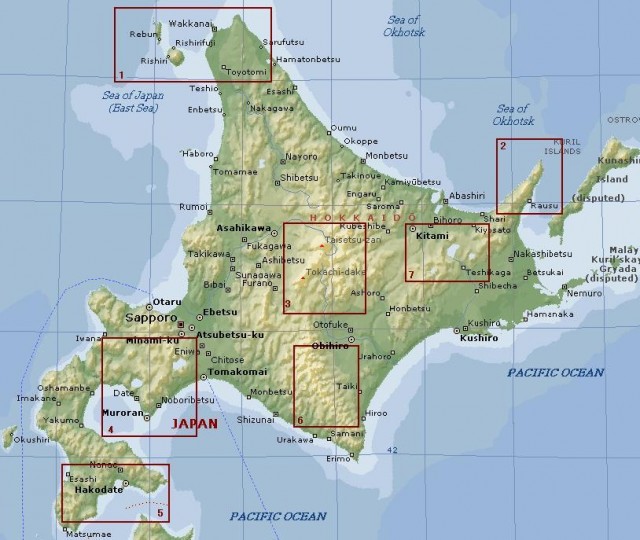Hokkaido Island
NORTHERNMOST OF the four main islands of JAPAN, Hokkaido is surrounded by the Sea of Okhotsk to the north and east, the Sea of Japan to the west, and the PACIFIC OCEAN to the south. Its northern location and frigid ocean currents from the Sea of Okhotsk make Hokkaido's climate considerably colder and drier than the rest of Japan; the island is known for its long winters. Hokkaido is about the size of IRELAND, and almost square in shape, roughly 186 mi (300 km) on each side.
Japan and RUSSIA dispute territorial jurisdiction over four small islands to the north of Hokkaido (Etorofu, Kunashiri, Habomai, and Shikotan). Japan had exercised control over these islands until the former Soviet Union occupied them at the end of World War II. (Jurisdiction over the much larger island of Sakhalin, or Karafuto as the Japanese call it, is split between Japan and Russia.) Hokkaido was only fully incorporated into Japan in modern times. Until the 19th century, most of Ezo (the previous name for Hokkaido) was a wilderness, home to the indigenous Ainu people. Today, the population of Ainu in Hokkaido has dwindled to about 16,000 from death and assimilation. Many place names in Hokkaido are in the Ainu language, including the prefecture's capital, Sapporo, and cities such as Kushiro and Muroran.

Japan's Meiji government renamed the island Hokkaido in 1869, set national borders encompassing the entire island as part of Japan, and encouraged settlers to move north. Yet Hokkaido remains sparsely populated by Japanese standards. Its population of about 5.7 million is less than 5 percent of Japan's overall population. On the other hand, Hokkaido's area of 30,315 square mi (78,515 square km) makes it the second- largest island in Japan (after Honshu). The large area of Hokkaido combined with its relatively small number of inhabitants yields a population density of 186 persons per square mi (72 persons per square km), only about one-fifth the national average.
The forests of Hokkaido produce lumber and forest products, and the island is the largest source of coal in Japan, followed by southernmost major island of Kyushu. The waters around Hokkaido are rich sources of fish (including the local specialty of crab). Agriculture is another important part of the economy, and Hokkaido provides much of Japan's food, including potatoes, onions, beans, wheat, and milk and other dairy products. Although the climate is far less suited to wet paddy field agriculture than lands to the south, new seed types permit the growing of rice, the single largest crop in Hokkaido. In contrast to most of Japan, Hokkaido has many dispersed farmsteads, with much larger farms, and employs far more draft animals. Parts of Hokkaido resemble New England, with broad fields, rolling hills, and grazing cattle.
Tourism is another important part of the economy in Hokkaido. The island is home to several large national parks, with clear deep lakes, snowy mountains, and unspoiled forests. The first Winter Olympics to be held outside Europe or the United States were hosted by Sapporo in 1972. Every February since 1950, Sapporo has also held an annual Snow Festival, featuring ice sculptures and snow statues; the festival attracted 2 million visitors in 2003.
Development of Hokkaido has lagged behind the rest of Japan, in part because of the isolation of this northern territory and its separation from the main island of Honshu by long distances and the Tsugaru Strait. In 1988, the Seikan Tunnel linked Hokkaido with Honshu by underground rail, and the Bullet Train (Shinkansen) now has its northern terminus in Hokkaido. Yet because of the distances involved, air travel remains a common route to Hokkaido.